Table of contents
1 Introduction
1.1 Team members
2 Physics of HTS
2.1 Applications
3 HTS materials
4 HTS leads
5 Resistive leads
6 Other activities
7 Contracts
8 Publications
Introduction
|
The powering of the LHC
superconducting magnets will be made via 3250 current leads transporting in total
about 3 MA of current into the “cold-mass” of the LHC machine. They
will be installed in the LHC tunnel, where they will provide the electrical link between the room temperature
power cables and
the cold bus-bars, bringing the current from/to the cryo-magnets.
Among the LHC current leads, 1030 components incorporate a section with HTS
(High Temperature Superconducting) material. Optimized conventional
self-cooled current leads conduct into the liquid helium about 1.1 W/kA. For
the LHC HTS current leads, the use of HTS material allows a reduction of
heat load into the liquid helium by a factor of 10 if compared to
conventional self-cooled leads. The reduction in total cooling power is
about a factor of 3.
Following an intensive R&D
program, which started at CERN in early 1995, devoted to the test of high
current HTS elements,
the Bi-2223 tape with a silver-gold
alloy matrix has been
selected as the most suitable material for the LHC current lead application. The HTS current leads for the LHC machine represent the first application of HTS
material in a large scale accelerator system.
The HTS
current leads are used for circuits operating at ultimate currents comprised
in the range 600
A to13000 A. They are designed as three different types optimized for operating respectively at 600 A,
6000 A and 13000 A. They power the LHC main dipole and quadrupole
magnets, the dipole and quadrupole magnets in the matching sections and
dispersion suppressors and some of the
corrector magnets.
The remaining leads, which are resistive, feed the 60 A and 120 A
electrical circuits of the corrector magnets. They are 2024 in total and
they are designed as three different series: a series of 60 A and 120 A
conduction-cooled leads and a series of 120 A gas-cooled leads. In spite of their important number, these resistive leads transport only about 5 % of
the total current powering the LHC magnet circuits. They are of a special
design which was developed to satisfy the LHC requirements of
flexibility and compactness while having good electrical and thermal performance.
The design of all these LHC leads was made and validated at CERN with the construction and test of
prototype units. Key-issues of the design are the optimization of the
thermal and electrical performance, the compactness and sturdiness of
the components, which are conceived to guarantee continuous operation of the
magnet systems during the LHC lifetime. The final series are being
manufactured in industry and external laboratories on the basis of CERN “build-to-print” designs.
Mandate of
the AT-MEL-CF section
-
Optimization and design of all the current leads, both resistive and
superconducting, powering the LHC magnets;
-
Specification,
procurement, assembly and test of the HTS
material to be integrated in the superconducting current leads;
-
Specification
and procurement of all the current leads powering the LHC superconducting
magnets;
-
Qualification
and test in nominal operating conditions of all
superconducting current leads prior to installation in the LHC cryostats;
-
Specification
and procurement of the electrical ancillaries for the current leads to be installed
and operated in the LHC tunnel.
|

HTS-LTS Electrical joint

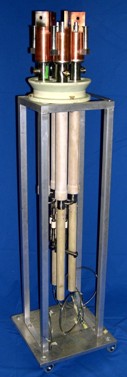
13000 A and 600 A HTS current leads
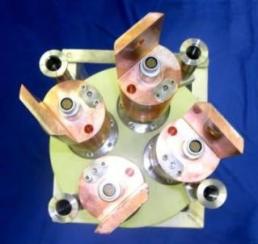
Top view of 600 A HTS current lead assembly |
Team members
| Name |
Main field of activity |
| Amalia Ballarino |
Section Leader |
| Pascal Chambouvet |
HTS materials, tests&assemblies, LHC on-call support |
| Philippe Denis |
Electro-mechanics for superconducting devices |
| Alain Gharib |
Cryogenic tests, electronics, LHC on-call support |
| Alain Jacob |
Electro-mechanics for superconducting devices |
| Stephen March |
PhD student-University of Southampton |
| Tiziana Miani |
ASP student-Politecnico of Torino (HTS leads-ITER) |
| Birgit Weckenmann |
Associated-GSI Darmstadt (HTS leads-FAIR) |
|
Physics of HTS
Since the discovery of High Temperature Superconductivity in
lanthanum copper oxides, discovery marked by the award
of the Nobel prize to Bednorz and Muller in 1987, no generally accepted
microscopic theory for the mechanism responsible for the superconductivity in
High Temperature Superconductors (HTS) has been formulated. After the lanthanum-barium-copper
oxide superconductors (La2-xBaxCuO4), having a
critical temperature of about 30 K,
other materials belonging to the same cuprate family were found to be superconducting
at even higher temperatures: the yttrium-barium-copper-oxide superconductors
YBa2Cu3O7, with a critical temperature of 92 K, the bismuth-strontium-calcium-barium oxide superconductors Bi2Sr2Ca2Cu3O10
and Bi2Sr2CaCu2O8, with a
critical temperature of 110 K and 85 K respectively and the thallium-barium-calcium oxide
superconductors Tl2Ba2Ca2Cu3O10,
with a critical temperature of 125 K. All these materials have as common
feature a crystal structure that includes layers of copper-oxygen planes,
through which the superconducting current flows.
In the BCS quantum-mechanical theory of conventional
superconductors, the electron flux consists of bound pairs of electrons. The
pairing is caused by an attractive force between electrons. The electrons are bound in Cooper pairs by
an electron-phonon interaction, i.e. by phonon-mediated pairing. The electron's
wave function that describes the pair is spherical, indicating that the chance
of finding one carrier in a Cooper pair given the position of the other falls
off at the same exponential rate in all directions in space. This pairing is said to
have s-wave symmetry.
The HTS superconductors display many of the well-known
properties of conventional superconductors, such as Josephson tunneling, vortex
structure, type II behavior and Meissner effect. However, they also have properties that are unusual for BCS-like
materials. Some of these are their high critical temperature, their linear dc resistivity
in the normal state and their extremely small coherence length, which is
comparable to the grain boundary thickness and therefore makes the weak-link
behavior a real problem for transport properties. In addition,
HTS are characterized by a large spatial anisotropy, which is due to their
layered crystal structure. These layers are composed of Cu-O planes, separated
from each other by planes of other oxides and rare earths. It is
believed that superconductivity and charge transport are mostly confined in the
Cu-O planes, called the ab planes, perpendicular to the c axis. This structural
anisotropy translates into anisotropy of most physical properties.
While it is admitted that there is some electron pairing
mechanism involved in high temperature superconductivity, the nature of the
pairing mechanism is not yet understood. It is considered that the pairing
interaction may not be phonon-mediated and may not be the same for all HTS
superconductors. Lattice vibrations alone are not strong enough to maintain electron pairing at elevated temperatures. Pairing mechanisms of magnetic origin have been proposed, mainly
to justify the high critical temperatures of HTS: the magnetic exchange energies
are about four times the phonon energies. In this case, the electron pairing
would have a wave function with d-wave symmetry. The d-state
appears as a four lobes lying in a plane, like a four-leaf clover. One of the
most dominant theories that contains d-wave symmetry is the spin wave model.
According to this theory, the carrier leaves a magnetic disturbance (a spin
wave) in its wake. This wake pulls a second carrier, so that the two forms a
Cooper pair. The spin waves are short-lived, so they are often called spin
fluctuations. However, some measurements are
in apparent contradiction with this picture. For instance, results of Josephson
tunneling experiments are an argument for the paired electrons being in a
spin-singlet s-state. It was pointed out that Josephson tunneling should not be
possible between paired electrons in two different superconductors unless they
have the same symmetry. The Josephson tunneling experiment between
yttrium-barium-copper-oxide superconductors and a Pb/Sn (an ordinary s-wave
superconductor) point contact, would be in favor of paired electrons in a s-state. Also, the temperature-dependent penetration-depth for HTS gives
weight to the argument that these materials are s-wave. Phonon mediated pairing
would be
consistent with the experimentally observed s-state pairing.
For the electron pairing mechanism,
other quasiparticles such as antiferromagnetic magnons or excitons have also been
proposed as pairing intermediates. Alternatively, other mixed mechanisms have
been considered, like a phonon-mediated mechanism with some sort of a booster to
increase the critical temperature of the superconductor.
The MgB2
superconductor, discovered in 2001 by a team
of Japanese researchers, does not belong to the family of cuprates. This superconductor,
with a critical
temperature of 39 K, is not a copper oxide: it is a much simpler compound that seems to represent a whole new
superconductor family, more than being simply a Low Temperature Superconductor (LTS) with an unusually
high critical temperature. The large isotope effect found in this superconductor
confirms the key role of electron-phonon coupling. However, the electronic
structure in MgB2 is such that there are two types of electrons at
the Fermi level, one of them being much more strongly superconducting than the
other. This is in contrast with the theory of phonon mediated superconductivity,
which assumes that all the electrons behave in the same manner.
It is certainly true that the HTS field
is still young and it evolves rapidly. It is also true that it took
45 years after the discovery of superconductivity in solid mercury at 4.2 K -by Kamerlingh Onnes
in 1911- to arrive at a solid understanding of conventional
superconductors through the microscopic BCS theory. While some practical HTS
superconductors are now being made and some applications are appearing, it is
felt that it may still be a long time before the physics of HTS is fully understood and explained in one -or more- theories
enjoying consensus among
theoretical physicists. Progress in the field has been, up to now, mainly driven
by experimental work. Finding a theory would probably help researchers to
address some of the problems encountered when working with this new generation
of superconductors.
Applications
HTS materials have already been used to demonstrate a variety of applications.
In the field of large-scale applications, where high currents and long lengths
are required, power transmission cables, fault current limiters, transformers, motors
and generators have been made using both 1st and 2nd generation HTS. For small-scale
applications, where more specialized properties of HTS tend to be used,
examples are detection systems and analog and digital processing.
Different type of materials are commercially available today:
-
Bi-2223 (Bi2Sr2Ca2Cu2Ox)
multi-filamentary tape (1st generation superconductor). This material is
available on the market in long (about 1 km) lengths. The tape, which is typically
about 4 mm wide and 0.2 mm thick, is produced with the Powder In Tube (PIT) process. It has a silver alloy matrix,
which is reinforced either by alloying or by attachment to a metallic
substrate to improve its strength tolerance.
-
Bi-2212 (Bi2Sr2CaCu2Ox) multi-filamentary wire and tape (1st generation superconductor). It
is also available in long lengths. Having a high critical field, it is
particulary suited for high current or high field applications at
temperatures below 20 K, such as inserts in high field magnets.
-
Y-123 (YBa2Cu3O7-x)
coated conductors (2nd generation superconductor), where a bi-axially
textured superconductor is coated on a flexible ribbon. This material is in
these days becoming available on the market in lengths of about 100 meters. It is expected to
replace the Bi-2223 because of its higher critical temperature and field and
the lower cost of raw materials.
-
Bulk melt-textured Y-123 and melt-cast processed Bi-2212
materials for novel applications such as magnetic bearings, magnetic
shields, flywheels and current limiters.
-
MgB2 in the form of bulk, tape and wire. It
can be produced either with in-situ (reaction between Mg and B) or ex-situ
(sintering of MgB2 powders) processes. It has a relatively low
critical temperature (39 K), but a high potential in view of the low cost of
raw materials and manufacturing processes. It is becoming available in long
lengths in the form of wire and tape.
In the LHC we take advantage of the unique properties of the
HTS material to reduce considerably the heat in-leak via the current leads. Stacks of Bi-2223 tape
in a silver-gold matrix are used to feed more than 3 MA of
current to the superconducting magnets operating at liquid helium temperature. The LHC current leads, which represent
the first application of HTS material for accelerator technology, provide a
unique opportunity to demonstrate the value of incorporating HTS materials into a
large scale system
HTS materials for LHC current
leads
|
As part of an intensive R&D program which started in early 1995 and ended in
2002, a full range of HTS materials were studied and tested at CERN. The
scope of this work was to
verify their current capability at temperatures of up to 77 K, their
suitability for reproducible low resistance and high current joints, their
behavior in case of resistive transition and their thermal performance.
These materials, tested either in the form of samples or integrated in prototype
current leads, were: Bi-2223 tape with various percentage of Au in the Ag
matrix, DIP coated Bi-2212, Melt Cast Processed Bi-2212, Accordion Folding
Method Bi-2223, Melt Textured Y-123, Ceramo Crystal Growth Y-123 and Laser
Floating Zone Bi-2212.
In view of its good thermal and electrical performance and established
quality control procedures associated with industrial scale production, the
Bi-2223 tape was identified as being the most suitable material for
application to the LHC HTS current leads.
Bi-2223 tape and Bi-2223 stacks
Thirty-one kilometers of Bi-2223 tape were purchased from two manufactures (AMSC
and EAS). The tape was specified to have superconducting filaments-
(Bi,Pb)2Sr2Ca2Cu3OX,
X »
10- embedded
in a silver alloy matrix doped with gold. The percentage of gold in the
matrix is in the range from 4 to 5.3 weight percentage.
The tape, 4 mm wide and 0.2 mm thick, was delivered in spools having a
minimum length of 100 metres. The measured average critical current of the
spools, at 77 K and in self-field, is about 100 A.
The Bi-2223 tape is
integrated in the current leads in form of stacks. A number of five to nine
tapes are vacuum soldered together to form a comparatively rugged conductor
transporting, at 77 K and in self-field, a current between 350 A and 600 A. This
activity of vacuum soldering of the tapes into stacks is performed at CERN:
the tape is inspected, cut to the required length, assembled into
appropriate moulds and vacuum soldered in the CERN vacuum soldering
facilities. About 10000 HTS stacks are being manufactured at CERN for
integration in the LHC current leads. As part of the quality control
program, all stacks are characterized in liquid nitrogen and in self-field. The n-exponent
value of the stacks, calculated
as the
slope of the logarithmic plot of the voltage versus current in the range
from 0.1
mV/cm
to 2
mV/cm,
is about 20. For all stacks, the critical current
is measured for electric fields of
0.1 mV/cm,
1 mV/cm
and 2.5 mV/cm.
For full
traceability, the spool and the stack characteristics and their
characterization curves
are stored in a database, together with the information related to
the current lead and to the LHC magnet circuit powered by the leads.
Some stacks, representative of each different type integrated in the current
leads, underwent a full characterization at 77 K and 65 K in magnetic
fields, parallel and perpendicular to stacks, of up to 0.5 T.
Short samples of Bi-2223 tape underwent tests of irradiation by fast
neutrons both at room and liquid nitrogen temperatures. It was found that
integrated doses of up to 5.10-15 cm-2 ,
equivalent to about 500 kGy, do not give rise to significant degradation of the
critical current of the tape.
To prevent "bubbling" of the stacks, which will be exposed during the LHC
operation to liquid helium and cold helium gas, a coating procedure has been
proposed and validated by CERN. It consists in the vacuum impregnation of
the HTS stacks with a thin layer of the polymer poly-para-xylene (ParyleneÒ).
The vacuum impregnation takes place at room temperature on the stacks
already assembled on the supporting structure that is part of the current
lead assembly.
|
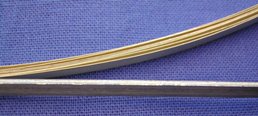
Stack of HTS Bi-2223 tapes
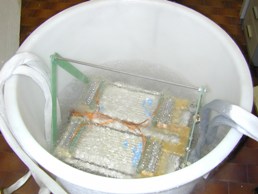
Characterization in of Bi-2223 stacks at 77 K
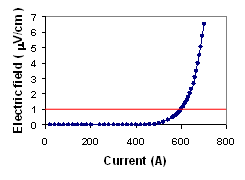
Critical current of a Bi-2223 stack meaured at 77 K and in self-field
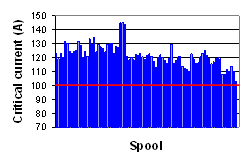
Average critical current of different spools (41 in total) of Bi-2223 tape

Micrograph of a Bi-2223 stack

Set-up for characterization of Bi-2223 stacks
|
LHC HTS Current leads
|
The LHC will require the transfer of more than 3 MA of current for the
powering of the superconducting magnets operating at superfluid helium
temperature. About 26 % of this current is transported by leads feeding the
main dipole and quadruple magnets (13000 A), 54 % by leads powering the
insertion magnets (3400 A-6800 A), 17 % by leads for the corrector
magnet circuits (600 A) and the remaining 5 % by leads for the dipole corrector
magnets (60 A-120 A). Prior to starting the design of the LHC leads, a study
was made to evaluate the exergetic costs of different cooling methods
available within the already well-defined infrastructure of the LHC machine,
and the potential saving in liquefaction power induced by the use of HTS
material. The most convenient
solution, finally adopted for all the LHC HTS current leads, consists in
cooling the resistive part of the lead with 20 K/1.3 bar helium gas,
recovered from the LHC beam screen cooling line, while the HTS element
operates in self-cooling conditions between an intermediate temperature (THTS) and the 4.5 K
liquid helium bath. The estimated saving in total cooling power with
respect to conventional self-cooled current leads, which conduct into the
helium bath about 1.1 W/kA, corresponds to 30 % while the heat
load into the liquid helium is reduced by a factor greater than 10.
These values were confirmed by several measurements performed at CERN on
prototype leads. It was decided to integrate HTS material in all the current
leads transporting currents ranging from 600 A to 13000 A.
The LHC HTS current leads operate in a temperature range between room
temperature and the saturated liquid helium bath. They consist of a
resistive section, convection cooled by helium gas available in the LHC
machine at a nominal temperature of about 20 K, and a superconducting
section, self-cooled by the vapour generated by the lead itself at 4.5 K.
The two circuits are hydraulically separated. The warm end of the
superconducting section, THTS, is maintained at 70 K in stand-by
operation and at 50 K in operation with current. Integrated within the
current lead body is the instrumentation required for its operation and protection: a platinum sensor, at the top of the HTS unit,
used for the control of the 20 K helium mass flow rate, and the voltage taps
which are provided for independent protection of the resistive (100 mV
threshold) and HTS part (5 mV threshold). Additional voltage taps are made
available for the protection of the magnet circuits.
The detailed design of the leads was made at CERN, where the prototype units
were also tested in cryogenic conditions. The leads are grouped in three
different series, designed for operating respectively at 13000 A,
6000 A and 600 A.
A pre-series of 140 units was manufactured and
assembled at CERN. The complete series of leads is being manufactured in CECOM, Rome, for the 13000 A leads and in the Russian laboratory of BINP,
Novosibirsk, for the 6000 A and 600 A current leads, on the basis of CERN
"build-to-print" designs. All HTS current leads are measured at maximum
current prior to installation in the LHC machine: the laboratory of ENEA,
Frascati, measures the series of 13000 A and 6000 A HTS current leads, while
the University of Southampton measures the series of 600 A HTS current
leads.
The 13000 A and 6000 A current leads are manufactured as single
units, while the 600 A current leads are assembled in a group of four on a
common insulating flange. The table below summarizes the typical performance
of the three different type of leads when operating at maximum current, as already repeatedly measured on hundred
of units.
| Current lead type |
Current (A) |
Mass flow rate of 20 K He gas (g/s) |
Heat load at 4.5 K (W) |
| 13000 A |
13000 |
≤0.63 |
<1.5 |
| 6000 A |
6000 |
≤0.3 |
<0.7 |
| 600 A |
600 |
≤0.034 |
<0.09 |
|
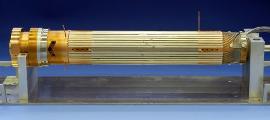
The 13000A HTS unit
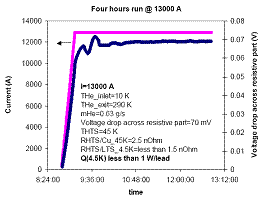

Test at CERN of 13000 A prototype lead. Measurements performed during a 4
hours run.

13000 A Heat exchanger |
LHC Resistive leads
|
The powering of
the LHC close orbit correctors will be made via 1504 current leads rated for a
maximum current of 60 A. Additional 520 current leads are needed for the
powering of the corrector magnets operating at currents of up to 120 A. At CERN, two different designs
were developed for these leads:
· a
conduction-cooled design, for all the 60 A leads and for part -324 in total- of the
120 A leads;
· a
gas-cooled design for the remaining 120 A current leads.
Conduction-cooled current leads
The
conduction-cooled current leads are integrated in the main vacuum insulation
of the LHC Short Straight Section (SSS) cryostats. They transport the
current from room temperature to the 1.9 K liquid helium bath. In view of
their important number and of the strong space constraints imposed by the
cryostat configuration, they are assembled in a group of four on a common
stainless steel flange. They are pre-shaped as requested by the integration
requirements, which require that these leads are the last components to be
integrated into the already densely packed LHC cryostats.
An hybrid
conductor, electrical insulated via a multilayer Kapton® tube, is first
inserted in a thin stainless steel tube and then pre-shaped with a tooling,
specially developed at CERN. The four tubes are finally welded to the warm
and cold stainless steel flanges. The hybrid conductor is a red brass rod that
is copper plated along the entire length with two different copper
thickness (thinner in the lower part). This hybrid conductor was chosen in order to minimize the heat
load into the helium bath while assuring good stability in case of thermal
run-away. The conductors of each assembly are thermalized against two heat
sinks that are fixed to two cryogenic lines carrying gas
at 50 K-75 K and at 5 K-20 K respectively. The heat sinking at intermediate
temperatures is made in order to minimize the heat losses into the liquid
helium bath.
The design of
these leads is extremely compact. It has the advantage, when compared to
conventional self-cooled leads, of not requiring warm valves and pipes for
the control and recovery of the helium flow. It avoids the use of cold
vacuum-tight ceramic feedthroughs. In addition, thanks to the material choice and to the good
design of the heat sinks, the leads have good thermal performance. The calculated
losses into the helium bath of the a 60 A current leads are < 90 mW
at 15 A, which is the average current estimated for these corrector
magnets, and 170 mW at maximum current. For comparison, a conventional
conduction-cooled current lead operating at 60 A would conduct about 2.5 W into the bath.
The predicted thermal and electrical performance of the 60 A current leads have been
confirmed by precise measurements performed on series components integrated in a
ad-hoc cryostat built in the
University of Southampton.
The series
production on the 60 A and 120 A conduction-cooled current leads is being
manufactured on the basis of a CERN "build-to-print" design respectively in
Mark&Wedell, Copenhagen, and in CECOM, Rome.
Gas-cooled current leads
The
gas-cooled current leads are integrated in cryostats, located in the
insertion regions of the LHC machine, which house also the HTS current
leads. They transport the current from room temperature to the 4.5 K liquid
helium bath. The design is very compact. Depending on the requirements of
the powering, the leads are assembled in groups of four or eight on a common
supporting flange. The novelty of this design with respect to conventional
self-cooled current leads consists in extracting the heat from the leads of
the same assembly via common heat exchangers, cooled by the gas produced by
the thermal conduction of the leads themselves at 4.5 K. This solution has
two important advantages: the reduction in the number of valves
needed for the cooling of the leads from one per lead to one per lead
assembly, with significant economical savings in particular in view of the
important number of leads, and the compactness of the design, which is made
possible also by the simplification of the cooling scheme. The thermal
performance of these leads is comparable to the one of conventional
self-cooled current leads optimized for the same current rating.
|
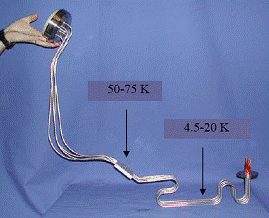
60 A Current Lead Assembly

60 A Current Lead Assembly in LHC cryostat
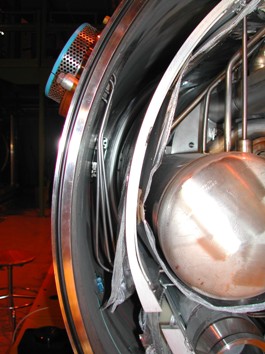
120 A current lead assembly in SSS cryostat
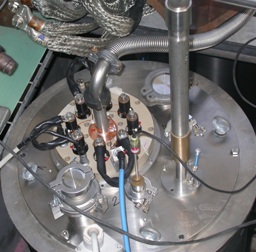
Cryogenic test, in ENEA, of 120 A
gas-cooled current lead
assembly (8 leads)

120 A gas-cooled current lead assembly |
Other activities
As part of the
laboratory activity, assembly work and different types of measurements are
performed within the AT-MEL-CF section. The latter include both series measurements on the current
leads that are carefully checked prior to integration in the LHC tunnel - leak tightness,
high voltage electrical
insulation and instrumentation tests - and measurements on different type of
materials to verify their thermal and electrical properties at cryogenic
temperatures. In particular, the following measurements are performed:
-
RRR
(Residual Resistivity Ratio) measurements;
-
Thermal
conductivity measurements in the range from 50 K to 4.2 K;
-
Critical
current measurements of HTS materials at liquid helium and liquid nitrogen
temperatures.
The
section is also in charge of the specification, procurement and supply of the
electrical equipment needed for the operation of the current leads in the LHC
tunnel. This is the equipment required for the powering and control of the
cartridge heaters integrated at the top of the leads to avoid condensation in
stand-by conditions and includes more than a thousand of isolation
transformers, heaters and heater control units and kilometers of power and
instrumentation cables.
Contracts
|
While the conception, the optimization and the detailed design of the LHC leads was made at CERN, where prototypes of each type of current lead were built and tested, the series production of the components is being carried out in companies and external laboratories on the basis of the CERN
specifications and drawings. The electrical characterization
at cryogenic temperatures of the series of HTS leads is also made by external laboratories.
-
Manufacture and supply of 13000 A HTS Current leads. CERN
Technical Specification document IT-3168/AT/LHC: Manufacture and Supply of
13000 A HTS Current Leads, September 2003, Amalia Ballarino. Contractor: CECOM, Frascati, Italy.
-
Manufacture and supply of 6000 A HTS Current Leads. CERN
Technical Specification document: Manufacture and Supply of 6000 A HTS
Current Leads, June 2004, Amalia Ballarino. Collaboration
Agreement with BINP, Novosibirsk, Russia.
-
Manufacture and supply of 600 A HTS Current Leads. CERN
Technical Specification document: Manufacture and Supply of Assemblies of
600 A HTS Current Leads, June 2004, Amalia Ballarino. Collaboration Agreement with BINP,
Novosibirsk, Russia.
-
Manufacture and Supply of 60 A conduction-cooled Current Leads.
CERN Technical Specification document IT-2901/AT/LHC: Manufacture and Supply
of Assemblies of 60 A resistive Current Leads for the LHC Dipole Corrector
Magnets, June 2002, Amalia Ballarino. Contractor: Mark&Wedell,
Copenhagen, Denmark.
-
Manufacture and supply of 120 A conduction-cooled Current Leads.
CERN Technical Specification document DO-21889/AT/LHC: Manufacture and
Supply of Assemblies of 120 A Current Leads for the LHC Dipole Corrector
Magnets, May 2004, Amalia Ballarino. Contractor: CECOM, Frascati,
Italy.
-
Manufacture and supply of Bi-2223 tape. CERN Technical
Specification document IT-3143/AT/LHC, Manufacture and Supply of BSCCO 2223
Au-Au Tape, March 2003, Amalia Ballarino. Contractors: ASC, USA, and EAS, Hanau,
Germany.
-
Cryogenic Test of 13000 A and 6000 A HTS Current Leads.
CERN Technical Specification document IT-3303/AT/LHC: Cryogenic Testing of
HTS Current Leads, March 2004, Amalia Ballarino. Contractor: ENEA, Frascati,
Italy.
-
Cryogenic Test of 600 A HTS Current Leads. CERN Technical
Specification document IT-3303/AT/LHC: Cryogenic Testing of HTS Current
Leads, March 2004, Amalia Ballarino. Contractor: University of Southampton, UK.
-
Cryogenic Test of 60 A and 120 A conduction-cooled current leads.
Collaboration Agreement No. CA 1298831, University of Southampton.
-
Electrical characterization of HTS Bi-2223 stacks.
Collaboration Agreement No. CA 1298846, CESI, Milano, Italy.
-
Design and production of prototype assembly of 50 A conduction-cooled current leads,
License and Consultancy Agreement with Desy, Hamburg, Germany.
-
Irradiation measurements on HTS materials,
Collaboration agreement with the Russian Research Centre "Kurchatov"
Institute (terminated).
In addition to the above listed contracts and collaboration
agreements, some activities related to the current leads project are performed
in-house. These activities are:
-
Production of more than 10000 Bi-2223 stacks, in collaboration with the CERN specialists of vacuum soldering and vacuum brazing technologies.
-
Manufacture and assembly of 120 A gas-cooled current leads, in collaboration with the CERN Main Workshop.
|
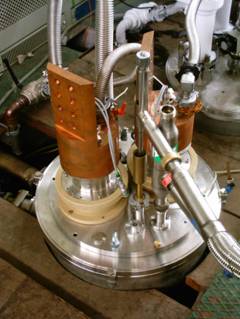
Test in ENEA of 13000 A HTS current leads
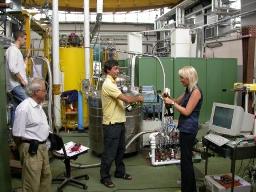
Test in ENEA of 13000 A HTS current leads
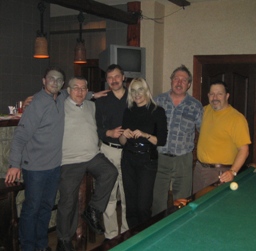
CERN and BINP team in Novosibirsk
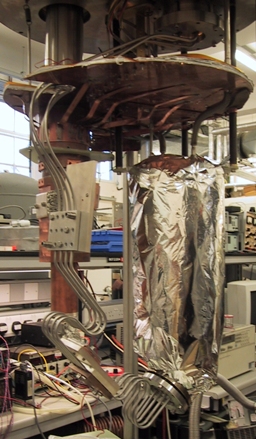
Test in Southampton of 60 A current leads

Test in Southampton of 600 A current leads |
Publications
List of main publications
First Test of Twisted-Pair HTS 1 kA Range Cables for Use in Superconducting Links, Proceedings of EUCAS 2011
First Electrical Characterization of Prototype 600 A HTS Twisted-Pair Cables at Different Temperatures, Proceedings of EUCAS 2011
Design of the HTS Current Leads for ITER, Proceedings of MT-22 (2011)
Alternative Design Concepts for Multi-Circuit HTS Link Systems, A. Ballarino, ASC 2010, IEEE Transactions on Applied Superconductivity, Vol. 21, No.3, June 2011
Design of an MgB2 Feeder System to Connect Groups of Superconducting Magnets to Remote Power Converters, A. Ballarino, EUCAS 2009, Journal of Physics: Conference Series 234 (2010) 032003
Scaling of Superconducting Switches for Extraction of Magnetic Energy, A. Ballarino and T. Taylor, IEEE Transactions on Applied Superconductivity, Vol. 20, No.3, June 2010
Conceptual Design of the LHC Interaction Region Upgrade - Phase I,
The LHC upgrade team, LHC Project Report 1163, CERN,
November 2008
Power Switches utilizing Superconducting Material for Accelerator Magnets,
S. A. March, A. Ballarino,
Y. Yang, ASC 2008, Chicago
Commissioning of the LHC Current Leads,
A. Ballarino, S. A. March, K. H. Meb,
EPAC 2008, Genova
Performance of
the Superconducting Corrector Magnet Circuits during the Commissioning of
the LHC, The LHC
commissioning team, EPAC 2008, Genova
Large-Capacity
Current Leads, A. Ballarino, ISS 2007, Tsukuba
Extending the
use of HTS to Feeders in Superconducting Magnet Systems, A.
Ballarino,
K. H. Meb, T. Taylor, MT-20 2007, Philadelphia
Toward the Design of Power Switches
utilizing HTS Material, S. A. March, A. Ballarino, C. Beduz,
K. H. Meb, Y.Yang, EUCAS 2007, Brussels
Extending the
Application of HTS in Particle Accelerators, A. Ballarino,
K. H. Meb, T. Taylor, EUCAS 2007, Brussels
Quench
Characteristics of Ag/AuBi2223 HTS-stainless steel stack used for the Hybrid
Current Leads of the Large Hadron Collider, M. K. Al-Mosawi,
S. Avgeros, C. Beduz, Y. Yang and A. Ballarino, EUCAS 2007, Brussels
HTS Current Leads:
Performance Overview in Different Operating Modes, A. Ballarino, ASC 2006, IEEE Transactions on Applied Superconductivity, Vol.17, No. 2, June 2007
The Commissioning of the LHC Technical Systems, The LHC Hardware Commissioning Team, Proceedings of PAC 2007
Large Scale
Assembly and Characterization of Bi-2223 HTS Conductors, A.
Ballarino, L. Martini, S. Mathot, T. Taylor and R. Brambilla, Proceedings of ASC
2006, August 2006, Seattle
Full Cryogenic Test
of 600 A HTS Hybrid Current Leads for the LHC, M.K. Al-Mosawi,
S.A. March, C. Beduz, A. Ballarino and Y. Yang, Proceedings of ASC 2006, August
2006, Seattle
Cryogenic Test of High Temperature Superconducting Current Leads at ENEA, Advances in Cryogenic Engineering: Transactions of the Cryogenic Engineering Conference, Vol. 51, 2006
DC and AC
Electrical Characterization of Stacks of HTS Tapes, S. Ginocchio,
A. Ballarino, E. Perini, S. Zanella, Proceedings of ASC 2006, August 2006,
Seattle
HTS in the LHC &
in the LHC Upgrades, A. Ballarino, WAMDO Workshop, CERN, April
2006
Conduction-cooled 60 A resistive current
leads for the LHC dipole correctors, A. Ballarino, LHC Project Report
691, March 2004
13000 A HTS Current
Leads for the LHC Accelerator: from Conceptual Design to Prototype Validation,
A.Ballarino, S.Mathot, D.Milani, Proceedings of EUCAS 2003, September 2003,
Sorrento, Italy
Effect of fast neutron
irradiation on transport properties of HTS materials, T.Taylor,
A.Ballarino, A. Ryazanov et al, Proceedings of EUCAS 2003, September 2003,
Sorrento, Italy
First Results and Status of the LHC String 2, The String 2 Team, Proceedings of EPAC 2002
HTS
Current Leads for the LHC Magnet Powering System, A.Ballarino, Physica C
372-376 (2002) 1413-1418, Invited Paper at the EUCAS 2001 Conference, August
2001, Lyngby, Denmark
Current Leads for
the LHC Magnet System, A.Ballarino, Invited Paper at the 17th
International Conference on Magnet Technology, 24-28 September 2001, Geneva,
Switzerland
Application of High Temperature Superconductors to Accelerators,
A.Ballarino, Invited Paper at the Seventh European Particle Accelerator
Conference, 26-30 June 2000, Vienna, Austria
High Temperature
Superconducting Current Leads for the Large Hadron Collider, A.Ballarino,
Presented at 4th European Conference on Applied Superconductivity, Sitges,
Spain, September 1999, LHC Project Report 337
120 A
Current Leads for the DFBs, A.Ballarino, Engineering Specification, LHC
Project Document No. LHC-DFL-ES-0002,January 2005
LHC HTS Current
Leads, A.Ballarino, Functional Specification, LHC Project Document No.
LHC-DFL-ES-0001,July 2003
IT-2901/AT/LHC,
A.Ballarino, Technical Specification for the Manufacture and Supply of
Assemblies of 60 A Resistive Current Leads for the LHC Dipole Corrector Magnets,
LHC Project Document No. LHC-DFLD-CI-0001, June 2002
IT-3143/AT/LHC,
A.Ballarino, Technical Specification for the Manufacture and Supply of HTS BSCCO
2223 Ag-Au Tape, LHC Project Document No. LHC-DFLHT-CI-0001, March 2003
IT-3168/AT/LHC,
A.Ballarino, Technical Specification for the Manufacture and Supply of 13000 A
HTS Current Leads, LHC Project Document No. LHC-DFLA-CI-0001, September 2003
IT-3303/AT/LHC,
A.Ballarino, Technical Specification for the Cryogenic Testing of HTS Current
Leads, LHC Project Document No. LHC-DFL-CI-0005, March 2004
IT-600A,
A.Ballarino, Technical Specification for the Manufacture and Supply of
assemblies of 600 A HTS Current Leads, LHC Project Document No.
LHC-DFLB-CI-0001, June 2004
IT-6000A, A.Ballarino,
Technical Specification for the Manufacture and Supply of 6000 A HTS Current
Leads, LHC Project Document No. LHC-DFLC-CI-0002, June 2004
DO-21889,
A.Ballarino, Technical Specification for the Manufacture and Supply of
Assemblies of 120 A Current Leads for the LHC Dipole Corrector Magnets, LHC
Project Document No. LHC-DFL-CI-0001, May 2004










